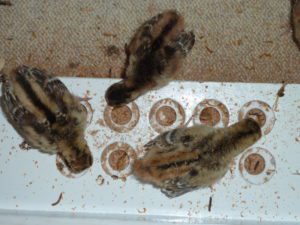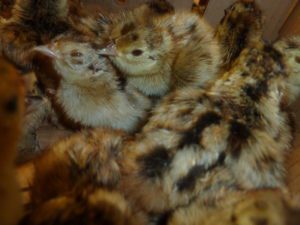Dr. Joah Madden studies pheasants, a type of bird frequently seen in the British countryside. How many of us have driven down a country lane with one of them zig-zagging a few feet in front of the car’s wheels for what feels like miles? We bellow “Look, there’s a gap in the hedge there! It’s massive! Just go through!”. The pheasant veers towards the verge, but at the last minute, the apparently suicidal bird flings its itself back into the road, and we continue a game of chase which neither party wishes to play.
Based on this all-too-common scenario, it seems like pheasants have earned the unflattering label of “bird-brained”. But is that really such an insult? It’s actually their surprising intelligence and personalities that are the focus of Dr. Madden’s studies. Captively-reared but wild-living pheasants in fact represent a particularly tractable study system in which to address some of the most topical questions in the field of cognitive evolution.
 In the UK, more than 40 million pheasants are released every year as game birds. These birds are raised in controlled conditions which can be experimentally manipulated, and when released into the wild aged around 2 months, they can be observed, and their survival and reproductive success recorded.
In the UK, more than 40 million pheasants are released every year as game birds. These birds are raised in controlled conditions which can be experimentally manipulated, and when released into the wild aged around 2 months, they can be observed, and their survival and reproductive success recorded.
When I spoke to Dr. Madden, an Associate Professor in the University of Exeter’s School of Psychology, he was standing in a field, fixing a hole in the pheasant holding-pen, through which his study subjects were enthusiastically escaping. Despite this, displaying a cognitive coherence and calm personality type to which his pheasants can only aspire, he outlined his research questions and experimental procedure.
Over recent years, he and his team have followed two related research threads. First, they have been exploring how variation in an individual’s personality (i.e. behavioural traits, for example boldness towards predators, which are consistent within, but differ between individuals within a population) and their cognitive performance in psychometric tasks, relate to their survival. Second, with collaborators at the Game and Wildlife Conservation Trust, he has been testing how the conditions experienced by pheasants in early life affect their physical, behavioural and cognitive development, and consequently, their fate after release.
During the Spring of 2011, Dr. Madden and his colleague Dr. Mark Whiteside conducted personality tests on 450 young game pheasants before they were released onto a shooting estate1. They then noted when individuals were shot, or succumbed to either disease or predators. They found that pheasants which were shyer as juveniles survived longer after their release into the wild. Bold males were shot first, and were also more likely to die from disease or predation. Among females, the individuals most likely to die from disease or predation were those who had been shyer as juveniles. The results show that even apparently unselective hunting can select for particular personality/behavioural traits in released game birds.
 This begs another question – what causes the individuals to differ? If being bold increases the chances of being shot, why aren’t all birds equally shy? One hypothesis is that the differences emerge in response to variation in the world individuals experience as juveniles. To investigate this possibility, the team ran experiments in which they manipulated two important aspects of a chick’s early rearing environment: diet and spatial complexity.
This begs another question – what causes the individuals to differ? If being bold increases the chances of being shot, why aren’t all birds equally shy? One hypothesis is that the differences emerge in response to variation in the world individuals experience as juveniles. To investigate this possibility, the team ran experiments in which they manipulated two important aspects of a chick’s early rearing environment: diet and spatial complexity.
In the first experiment2, they gave several hundred birds a standard diet of commercial bird feed – uniform, milled processed pellets. To a similar number of birds, they gave a more natural and varied diet which included a mix of seeds and grains, as well as live mealworms. They found that birds reared with the more complex diet were less likely to be found dead after release.
Four mechanisms were identified to explain this. Pheasants reared with more naturalistic diets:
- Foraged for less time and had a higher likelihood of performing vigilance behaviours, so perhaps could better avoid predators
- Were quicker at handling live prey items, so perhaps had developed better motor skills, enabling them to deal with wild animal prey more efficiently
- Were less reliant on supplementary feed, which is commonly withdrawn when the shooting season ends
- Developed different gut morphologies which may make absorption of nutrients more efficient
So, a simple change in diet during their early lives effected complex changes to behavioural patterns, morphological traits, and motor skills.
In Dr. Madden’s second experiment3, one-day old chicks were raised in heated sheds, with added access to open grass runs from 2 weeks of age. For some, this was all the mental stimulation that their physical environment contained. For others, they experienced the 3rd dimension. Horizontal perches were placed in their pens the growing birds could clamber and fly onto. Shortly before their release into unroofed holding pens at 7 weeks of age, physical measurements were taken, some were fitted with radio-transmitters, and the birds underwent a range of tests which assessed a key element of their cognition: their spatial memory.
Following the bird’s release into the wild, they wer e checked frequently as they explored their new environment. Through visual observations, as well as radio-tracking those wearing transmitters, the survival of individuals was recorded. To see where the birds spent the night, the researchers even ventured out wearing night-vision goggles, enabling them to spot the birds roosting up in the tree tops.
e checked frequently as they explored their new environment. Through visual observations, as well as radio-tracking those wearing transmitters, the survival of individuals was recorded. To see where the birds spent the night, the researchers even ventured out wearing night-vision goggles, enabling them to spot the birds roosting up in the tree tops.
Some more intriguing results were revealed. Firstly, individuals raised in a more complex spatial environment developed thicker leg bones, and were better able to reach and perch on high branches for the duration of the night. Fascinatingly, these birds also developed more accurate spatial memories and were more likely go up into the trees to roost. Consequently, they were less likely to be killed by predators. So another simple change in early life experience – the addition of perches – had a profound effect on physical and cognitive development, and therefore, on chances of survival. The research may provide clues as to how early life experiences may influence how personalities and cognitive traits develop in humans.
Dr. Madden and his team have also been using pheasants to challenge some of the basic assumptions on which some of the most commonly used tests in cognitive research are based. It is logical to infer that one individual who outperforms another in a problem-solving task possesses some characteristic which makes it better at the task. But is this characteristic cognitive ability? For example, food is often used as the reward for completing a task. But wouldn’t a hungry bird presumably be more anxious to succeed than a full one? In such a case, the “better problem-solver” would simply be the one who was more motivated to fill its belly.
 Scientific methodologies are always designed to control for these effects. However, findings which Dr. Madden recently published with Dr. Jayden van Horik4 suggest that the factors which mediate motivation and willingness to engage with the task can be far more complex and obscure than previously thought. Their results showed that an individual’s level of performance was consistent within the same or similar tasks, but not across different tasks. This suggests that it isn’t possible to say that some individuals were generally good or bad at solving such problems. If such inferences are unsound, then it’s possible that these findings could have important implications for the field of cognitive research.
Scientific methodologies are always designed to control for these effects. However, findings which Dr. Madden recently published with Dr. Jayden van Horik4 suggest that the factors which mediate motivation and willingness to engage with the task can be far more complex and obscure than previously thought. Their results showed that an individual’s level of performance was consistent within the same or similar tasks, but not across different tasks. This suggests that it isn’t possible to say that some individuals were generally good or bad at solving such problems. If such inferences are unsound, then it’s possible that these findings could have important implications for the field of cognitive research.
Ongoing work in Dr. Madden’s research group is exploring whether cognitive flexibility predicts survival in the wild, how performance in specific cognitive tasks may relate to cognitive performance more generally, and how motivation and engagement in the tests employed by researchers may be biased by personality characteristics like boldness or persistence. Finally, the team are setting all of this cognitive behaviour within a broader ecological context, investigating how cognitive traits influence vigilance, ability to secure mate,s and various other aspects of a pheasant’s life in the wild.
Whether bold and beautiful or shyly scintillating, pheasants brighten the British countryside. And although their personalities and intellectual prowess may seem rather pedestrian by human standards, through some innovative research, we are perhaps learning something from these bird brains about what makes you, you.
This is a guest post written by Matthew Creasey, a PhD researcher and ecologist at the University of Exeter. He manages the Twitter feed of the University’s Behaviour research group: @UoE_Behaviour.
References
1 – Madden, J. R., & Whiteside, M. A. (2014).
Selection on behavioural traits during ‘unselective’ harvesting means that shy pheasants better survive a hunting season.
Animal Behaviour, 87, 129-135.
2 – Whiteside, M. A., Sage, R., & Madden, J. R. (2015).
Diet complexity in early life affects survival in released pheasants by altering foraging efficiency, food choice, handling skills and gut morphology.
Journal of Animal Ecology, 84(6), 1480-1489.
3 – Whiteside, M. A., Sage, R., & Madden, J. R. (2016).
Multiple behavioural, morphological and cognitive developmental changes arise from a single alteration to early life spatial environment, resulting in fitness consequences for released pheasants.
Open Science, 3(3), 160008.
4 – van Horik, J. O., & Madden, J. R. (2016).
A problem with problem solving: motivational traits, but not cognition, predict success on novel operant foraging tasks.
Animal Behaviour, 114, 189-198.


